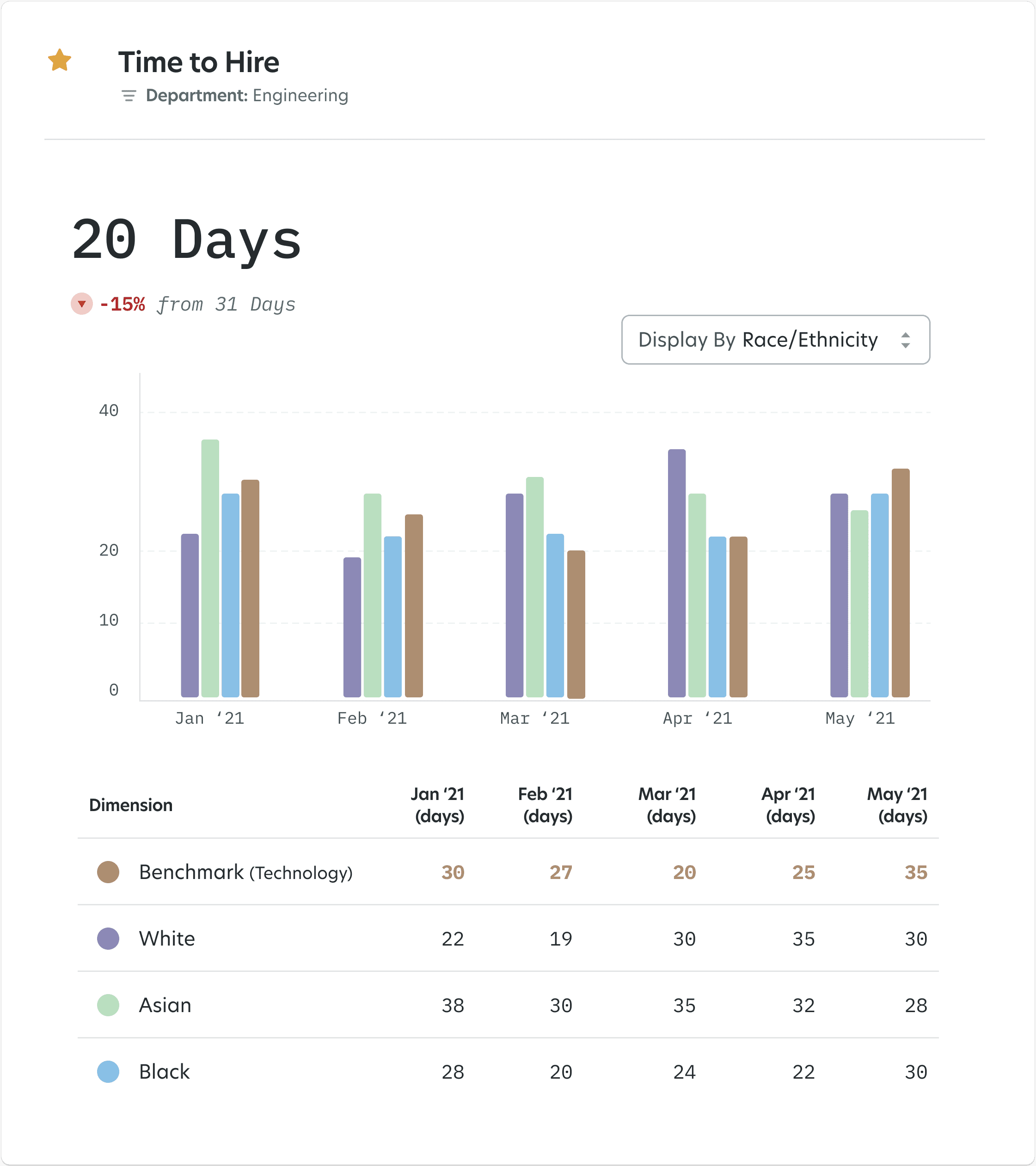HR Analytics
July 18, 2022
HR Benchmarking: What Is It And How Do You Get Started?
HR benchmarking is a continuous process for company advancement. It involves tracking and comparing data over time, across departments within an organization, or against data from competitors.
Benchmarking is a form of quality control, and understanding what it is and ways to use it can improve strategy.
What Is HR Benchmarking?
HR benchmarking is the regular evaluation and comparison of data between processes, sectors, and roles within an organization and against competitors or similar organizations in an industry. Benchmarking provides companies with different perspectives which influence overall performance.

What HR benchmarking looks like with eqtble
Types of Benchmarking In HR
There are two types of benchmarking
Internal Benchmarking
External Benchmarking
Internal benchmarking compares data of practices within an organization over some time or between different roles and departments.
Tracking and comparing these data are valuable to assess key performance indicators (KPIs) and set targets for KPIs.
Benchmarking within an organization sets the standard for evaluating processes.
External benchmarking compares the data between different organizations by evaluating processes across direct competitors or similar organizations in an industry. Knowing how a company is faring against industry standards is the basis for external benchmarking.
Companies utilize the different types of HR benchmarking in the following ways:
1. Process benchmarking
2. Strategic benchmarking
3. Competitive Benchmarking
4. Performance benchmarking
Process benchmarking compares the operational processes of an organization to similar organizations.
This benchmark highlights how companies achieve objectives and the potential for improving the processes related to operational performance like recruiting or onboarding process.
This information influences strategy and decision-making by HR and company leaders.
Strategic benchmarking compares successful strategies and approaches implemented by other organizations.
This benchmark evaluates campaigns and planning strategies of similar companies and highlights what works and what needs modification considering the objectives and KPIs of a particular company.
It identifies how a company ranks against competitors and the best approaches to adopt.
Competitive benchmarking compares the metrics and processes implemented by direct competitors.
This benchmark provides important insights on the success of competitors and the approaches needed to improve customer satisfaction and overall performance.
Performance benchmarking or functional benchmarking compares existing data with current outcomes relating to performance.
Comparing data across departments of an organization and updating the standards for optimal performance has an overall impact on function over time.
The Benefits of HR Benchmarking
According to Michel Theriault, author of Strategic Benchmarking: Beyond Numbers - Quick Guides for Managers, "Measuring results is the best way to improve what you are doing."
Benchmarking insights are valuable in several ways and improve organizational processes. Some of these benefits include the following:
1. Rank business against competitors
External benchmarking pits a company against peers and competitors and provides insight into how it fares in an industry.
Benchmarking enables a company to know its strengths and weaknesses based on industry standards.
These insights result in the evaluation of tactics and planning to develop winning strategies to improve performance and stay ahead of the competition.
2. Study workforce trends
Benchmarking keeps companies updated on workforce trends. Amid the global pandemic in 2020, more companies had campaigned for mental health promotion and wellness programs.
Continuous research yields insights on compensation, promotions, and benefits trends among competitors.
Benchmarks allow a company to stay ahead of the competition by reviewing compensation packages or benefits-such as the provision of health insurance against industry standards.
HR programs are planned by utilizing this information, thus enabling companies to top development in their industries and attract candidates.
3. Enhance existing practices
By monitoring and comparing data from processes involving recruitment, retention, engagement, and compensation organizations assess voids. Planning and implementing new or alternative strategies improve these voids.
For example, a company can compare its diversity, equity, and inclusion (DEI) data against the competition and work on a strategy to improve this benchmark.
4. Evaluate and improve employee growth and experience
Comparing the growth of employees evaluates the frequency of leadership training programs and job promotion rate.
Promoting employee growth boosts the long-term growth and success of the company, providing ready successors for key management roles.
5. Improve company culture
Benchmarking processes like recruitment, engagement, and compensation can improve employee experience and job satisfaction. Boosting employee morale promotes a healthy company culture.
What Can you Benchmark?
1. Organizational structure
The structure and design of organizations vary and play a role in the implementation of strategies. By comparing its internal structure, an organization can evaluate if it can achieve its goals.
2. Compensation package and benefits
Compensation benchmarking compares the salary and benefits offered in a particular role, organization, industry, and geographical area. Relevant data informs organizations if they are paying below industry standards or exceeding them.
3. HR costs
The cost of HR operations covers metrics like cost-per-hire and HR cost per employee. Comparing this data across similar organizations determines what HR costs can be reduced or increased.
4. Employee development
Benchmarking career development through an employee life cycle quantifies data such as; the number of vertical movements, leadership development training, and overall opportunities available to employees.
5. Work schedule and environment
Understanding how employees are treated-work schedule and the environment in which they operate optimizes business strategy.
6. Engagement and retention
Measuring employee engagement and retention is a direct measure of productivity and consistency. Measure engagement and retention scores internally across departments and adjust accordingly to improve the scores.
7. Health and productivity
Organizations assess how their health and wellness programs compare to other organizations and the impact on productivity.
Drawbacks to HR Benchmarking
1. Unfounded comparisons: HR benchmarking is a part of performance management as it provides performance-boosting insights. The insights used for decision-making are not an absolute standard.
Making decisions should not be influenced by an isolated study as variations in organizational structure, strategy, and size are factors to note. In certain circumstances, internal benchmarking offers more valuable insights than competitive benchmarking.
2. Speed of data collection: Data accumulates and changes with increasing speed. The data to be compared against can take some time to be collected, rendering it less relevant when available.
3. Implementation of best practice: After identifying areas of improvement, companies can take their time coming up with a strategy to make necessary changes. Adopting the best practices of 2019 in 2021 makes those changes redundant.
Best Practices in HR Benchmarking
Best practices are documented strategies and tactics employed by top-performing companies. To adopt best practices, organizations do the following:
Identify what to benchmark
Determine how to collect data
Analyze the data and define best practices.
Set goals for improvement
Design action plan to implement the changes
Monitor long term results and progress
Revise the benchmarks regularly
Benchmarking measures and challenges the status quo. By tracking these data, organizations notice gaps in operational processes and bridge these gaps.
Benchmarking insights inform these organizations about what is going well and what could be better, letting them meet or exceed industry standards.
Track your HR metrics seamlessly with eqtble.
Our team at eqtble has built the ability to compare your company's data to external benchmarks all within our tool.
Click here to request early access.







